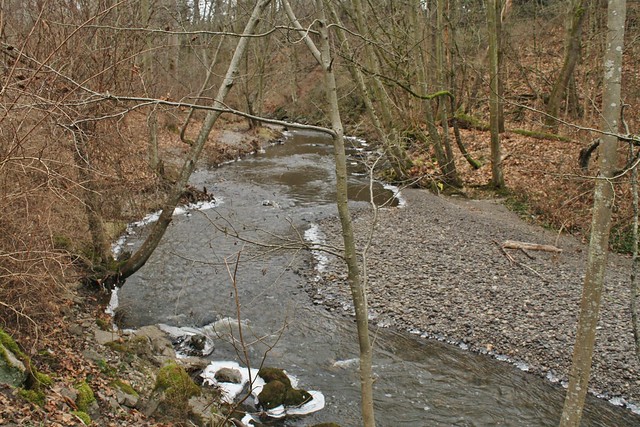
Squalicum Creek spawning grounds in December
I previously documented Bellingham’s creek habitat restoration efforts with the example of Padden Creek which is one of three salmon spawning streams that flow through the city of Bellingham and empty into Bellingham Bay and the Salish Sea. In this diary, I document the ongoing restoration of a second creek.
Squalicum Creek drains 22 square miles of multi-use land, starting in the foothills of the Cascade Mountains. On its 9.7 mile journey before emptying into Bellingham Bay, it runs through forest, farms, light industrial areas ,residential areas, by shopping malls and their parking lots, and along and under highways. It currently supports Pink (humpy), Chum (Keta) and Coho (silver) salmon along with a population of resident and sea-run cutthroat trout. Chinook (king) and Sockeye (red) salmon, and the occasional steelhead trout are found in the creek as well.
The state of this creek as a viable salmon habitat is a harbinger of our area’s environmental future. As goes the health of Squalicum Creek (and hundreds of similar streams), so goes the health of 62 different species that inhabit the creek’s watershed including 36 types of birds, 6 fish, 3 amphibian, and 2 reptile species. And of course homo sapiens, who, although an invasive species have become part of this ecosystem as well. The habitat is clearly worth saving for all concerned.
Like Padden Creek, Squalicum Creek has suffered numerous indignities such as having lost two thirds of its original 32 miles of salmon habitat through erection of barriers such as concrete flumes and culverts under roads and train tracks that block or make salmon passage difficult. Further, the stream has been rechanneled through two shallow man-made lakes (Bug Lake and Sunset Pond) along the freeway that were dug for fill dirt in the 1960s when Interstate 5 was being built.
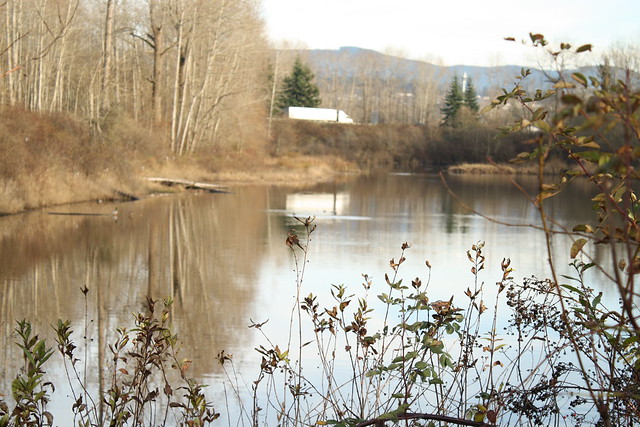
Bug Lake - notice the truck on the freeway in the background under which the creek runs.

Culverts drain Bug Lake into the newly constructed downstream channel. This conglomerate of metal culverts, cement slabs, and brackish water does not make
for a very inviting spawning grounds.
Below this eyesore and along the road, a hillside is shored up with concrete and railroad ties to prevent erosion and literally to keep houses from falling into the Creek. No self-respecting salmon would spawn in a concrete stream.
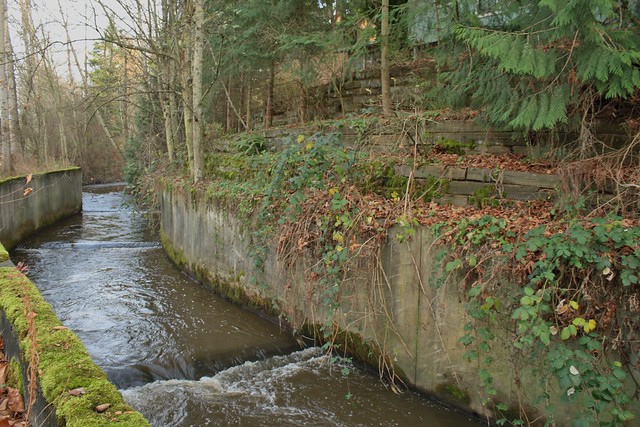
Note the railroad ties and the houses at the top right and center.
These accommodations to modernity result in less stream access for the salmon as well as attendant bacterial contamination, excessive channel erosion and siltation, oil and scum, and turbidity during storms. For many years a dead end road ran along the creek and served as a illegal garbage dump site. Many tons of trash were removed during early habitat restoration.
A few years ago, attention was called to the health of Squalicum Creek as significantly declining salmon returns became apparent. Further, the creek was found not to meet state standards for water quality and was listed as “Impaired” by The Department of Ecology. This was particularly distressing since Squalicum Creek had been assessed to have the highest potential for productive fish habitat within the city limits.
Subsequently, major restoration efforts were launched involving multiple entities and agencies that include: The Port of Bellingham, the Department of Ecology, the Department of Fish and Wildlife, the Department of Natural Resources (DNR), and the City of Bellingham. These agencies, working in concert with many volunteer groups (see below) have been working on the creek’s restoration since 2001 and continues to this day with more major work scheduled into the coming years.
Like Padden, Squalicum Creek’s restoration has been an arduous process, both in terms of the work itself and in the pursuit of funding from numerous agencies. The really good news is that although tight, funding is available, particularly when agencies work together on a common cause.
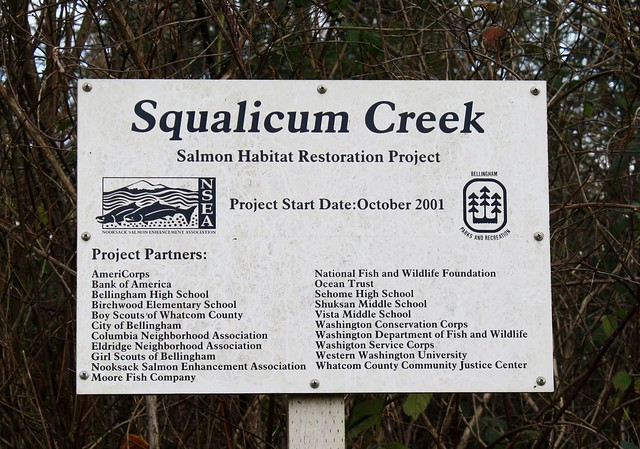
Among the grants received, the City of Bellingham was awarded Centennial Clean Water Fund Grants by the Department of Ecology in 2004 and 2005 to improve riparian areas along urban streams, including the Lower Squalicum Creek Restoration Project. In 2005, the City completed an extensive project to protect Squalicum from erosion, while improving fish habitat and restoring native vegetation.
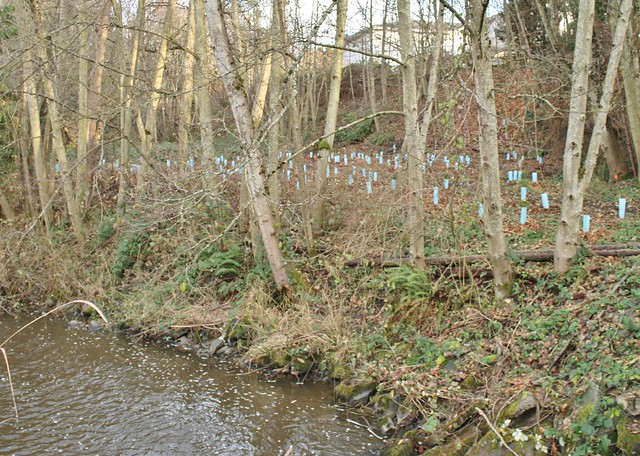
Riparian replanting: In each of the blue cylinders is a seedling tree, of cedar, alder, or fir.
The overall project (all phases) involves rerouting large sections of Squalicum Creek around two man-made ponds, through a new channel, reactivating remnant channels and reconnecting the stream with its floodplain. The project also will eliminate an existing fish passage blockage under I-5 and thereby open up and additional over 22 miles of upstream salmon habitat. The stream re-route projects will be designed with a thorough understanding of the hydrology, climate patterns, geology, and ecology of the watershed.
For example the city Public Works Department regularly measures a number of variables to monitor the health of the stream. They collect data on:
– Fecal coliform bacteria
– Temperature: These fish and particularly their eggs need cooler temperatures to survive.
– Dissolved oxygen: warmer water does not hold as much dissolved oxygen as cooler water.
– pH: Salmon eggs and fry are very sensitive to pH levels and begin to die if it is
below 6.5.
– Turbidity: suspended materials in water due to erosion can clog gills, smother living things, and cover spawning beds,
– Conductivity: Conductance of electric current is directly related to the total dissolved ions in the water and is an overall indication of water quality. Higher conductivities may be a sign of contamination in the water.
The first phases of the restoration were completed in 2005 and involved clean up of trash and garbage by the truck full, riparian restoration of native vegetation, and elimination of invasive vegetation along the lower portion of the stream just before it entered the bay.
Not only will this project reopen more spawning stream beds throughout the watershed, rerouting around the two ponds will significantly lower the stream temperatures. Cooling the water will in turn help restore oxygenation of the water.
Something seems to be working here already as the next sets of photos show. First, birds are hanging out here. See the little American Dipper on a rock in the center of the stream.

American Dipper (see center of photo), ready to dip into the water.

Juvenile Red Tail Hawk perching above the creek
Although this project continues to improve the stream’s habitat and its health, nothing is perfect. But maybe perfection, although desirable is not necessary. On December 4th, I observed the ancient spawning rituals of numerous Chum salmon in this creek within 15 feet of the highway and within sight of houses uphill. Several female Chum were busily digging redds by rapidly churning the creek bottom with their tails. Eagerly awaiting to contribute their DNA to the cause were a couple of males who were helping out with the digging as well. In the photos below you can see salmon constructing three different redds within a few feet of one another. It appears to be a communal affair and they really get into splashing their tails about to smooth out the stream bed. Happy Spawning.
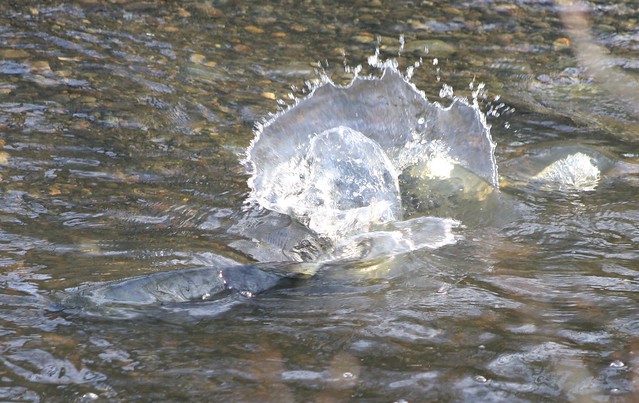
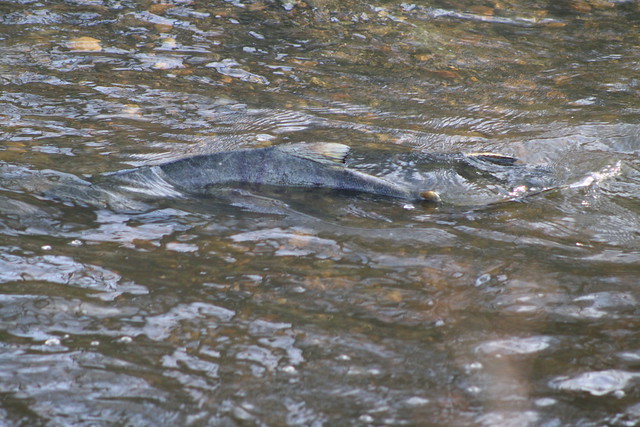

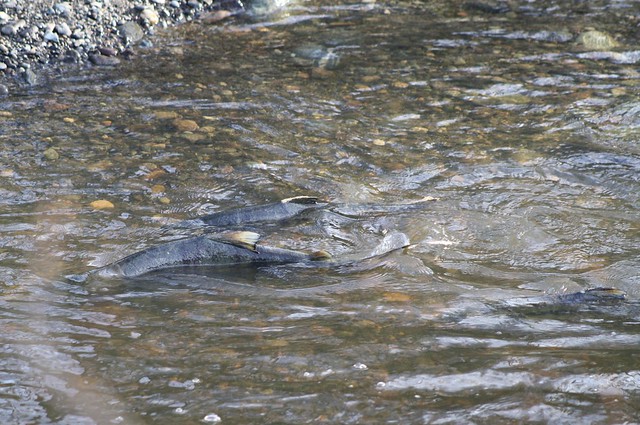
On December 6th, I went back to the creek, only to see an unknown source of foam floating in the stream. I have no clue of its source. I only hope that it does not harm the development of the newly deposited and fertilized eggs.
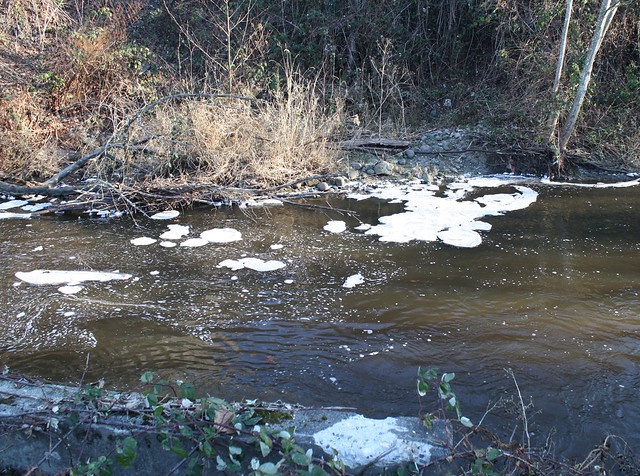
Unknown foam floating down creek.
learly, with the exception of this possible pollution, the stream is coming back to life. Although not teeming with spawning salmon as it once was, the creek continues to enable these marvelous creatures to do what they were bred to do. As is emblazoned on a bestselling t-shirt by Ray Troll at our local saltwater outfitting store: Spawn Until You Die
The final phase of this restoration project is to restore the viability of the estuary.
It is the first phase of a $4.1 million multiyear project that eventually will restore the estuary and eliminate a fish passage barrier to the Squalicum Creek watershed. The second phase of the project will replace the Roeder Avenue Bridge, modify the Burlington Northern/Santa Fe concrete box culvert rail bridge, replace existing sewer lines, remove a 350-foot long concrete channel bottom between the two bridges and re-establish a natural stream bed. Continuing projects will include removal of derelict bulkheads, pilings and other debris and new shallow areas will be created for salmon to reproduce, feed, rest, and hide from predators.
Since 2007 the Department of Natural Resources has removed 1,700 tons of creosote pilings from the estuary, remnants of long past industrial sites. More industrial detritis is slated to come out.
The photo below was taken from an overpass above Squalicum Way and the creek, looking across the railroad trestle and culverts under the road that are to be removed. The creek is seen in the bottom left as it runs under the trestle and into concrete flumes that carry it to the industrial waterfront that is its estuary. You can see that the estuary is bounded between various industrial buildings and a breakwater along with trucks and containers.
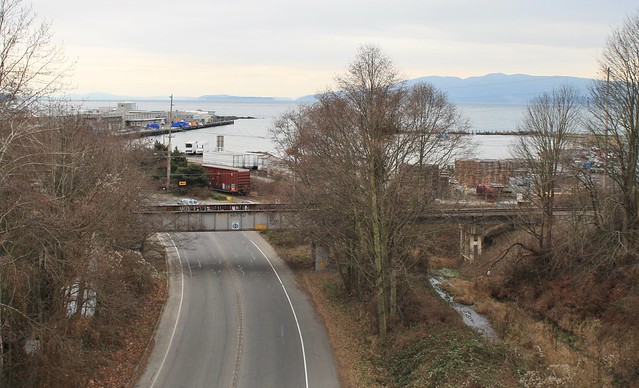
The estuary surrounded by waterfront industry
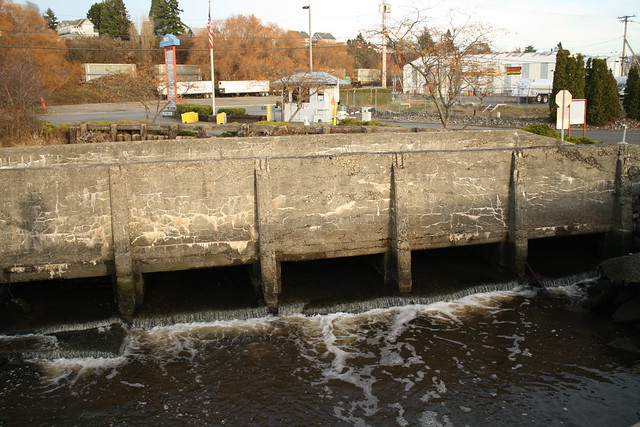
The salmon enter from the bay and estuary into Squalium Creek through this concrete bunker. It is amazing that any fish make it into the more natural part of the creek and spawn. They are amazing and truly intrepid critters.
The sign below illustrates the Port’s plans for completion of the estuary clean up.
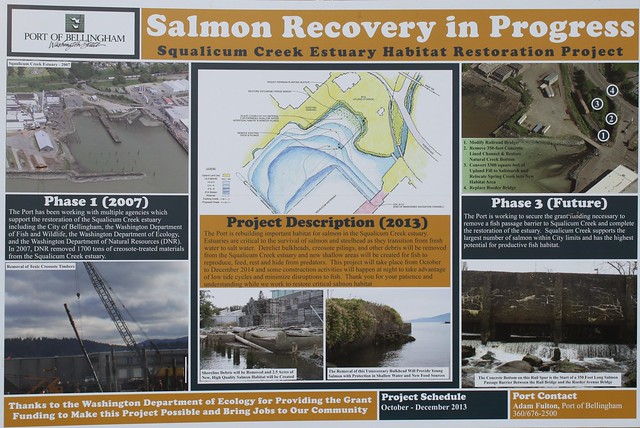
So, the clean up remains an ongoing effort with much restoration completed and more yet to be done on all of our creeks. The desecration of our once pristine environment that has been ongoing for the past 200 years is unlikely to be totally reversed for some time. Although today there is significant regulatory oversight of urban and industrial pollution, it remains a struggle to keep on top of those who would undo our progress for their immediate capital gain.
The map in this link shows the various sites of restorative efforts to rehabilitate the three spawning streams in Bellingham. A good deal of professional work has occurred, progress has been accomplished, but there is more to come.
Wish us luck in our pursuit of clean water, healthy fish, and a healthy planet.
At the risk of boring the good folks at the Moose, I have one more salmon stream story to tell. This one involves Whatcom Creek, the third spawning stream that runs through downtown Bellingham. However, it has a somewhat different story in that Whatcom Creek has a salmon hatchery on it that I will highlight. The hatchery serves as a conservation resource as well as an educational training center for salmon restoration and fisheries studies through our local technical college.
6 comments